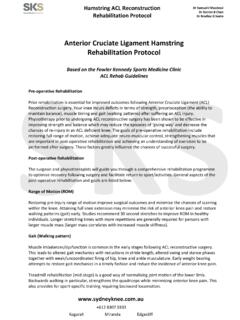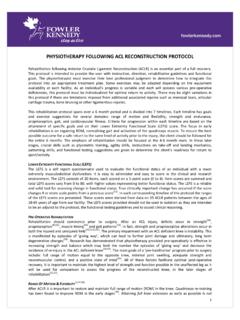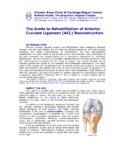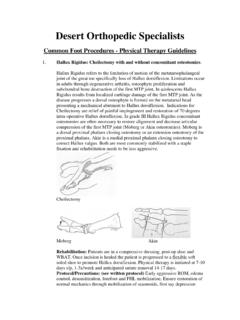Transcription of Anterior Cruciate Ligament Hamstring Rehabilitation …
1 +612 8307 0333 Kogarah Miranda Edgecliff Dr Samuel J Macdessi Dr Darren B Chen Dr Bradley G Seeto Hamstring ACL Reconstruction Rehabilitation Protocol Anterior Cruciate Ligament Hamstring Rehabilitation Protocol Based on the Fowler Kennedy Sports Medicine Clinic ACL Rehab Guidelines Pre-operative Rehabilitation Prior Rehabilitation is essential for improved outcomes following Anterior Cruciate Ligament (ACL) Reconstruction surgery. Your knee incurs deficits in terms of strength, proprioception (the ability to maintain balance), muscle timing and gait (walking patterns) after suffering an ACL injury.
2 Physiotherapy prior to undergoing ACL reconstructive surgery has been shown to be effective in improving strength and balance which may reduce the episodes of giving way and decrease the chances of re-injury in an ACL deficient knee. The goals of pre-operative Rehabilitation include restoring full range of motion, achieve adequate neuro-muscular control, strengthening muscles that are important in post-operative Rehabilitation and achieving an understanding of exercises to be performed after surgery. These factors greatly influence the chances of successful surgery.
3 Post-operative Rehabilitation The surgeon and physiotherapists will guide you through a comprehensive Rehabilitation programme to optimize recovery following surgery and facilitate return to sport/activities. General aspects of the post-operative Rehabilitation and goals are listed below: Range of Motion (ROM) Restoring pre-injury range of motion improve surgical outcomes and minimise the chances of scarring within the knee. Attaining full knee extension may minimise the risk of Anterior knee pain and restore walking patterns (gait) early.
4 Studies recommend 30 second stretches to improve ROM in healthy individuals. Longer stretching times with more repetitions are generally required for persons with larger muscle mass (larger mass correlates with increased muscle stiffness). Gait (Walking pattern) Muscle imbalances/dysfunction is common in the early stages following ACL reconstructive surgery. This leads to altered gait mechanics with reductions in stride length, altered swing and stance phases together with weak/uncoordinated firing of hip, knee and ankle musculature.
5 Early weight bearing attempts to restore gait mechanics in a timely fashion and reduce the incidence of Anterior knee pain. Treadmill Rehabilitation (mid-stage) is a good way of normalising joint motion of the lower limb. Backwards walking in particular, strengthens the quadriceps while minimising Anterior knee pain. This also provides for sport-specific training requiring backward locomotion. +612 8307 0333 Kogarah Miranda Edgecliff Dr Samuel J Macdessi Dr Darren B Chen Dr Bradley G Seeto Hamstring ACL Reconstruction Rehabilitation Protocol Muscle strengthening and endurance training Muscle contains Type 1 (endurance) and Type 2 (fast-twitch) fibres in varying amounts.
6 Following ACL injury, these fibres show signs of atrophy (wasting away) and changes in cellular composition. Therefore, ACL Rehabilitation requires focus on both these different types of fibres namely; low-load/high repetitions (endurance) and high-load/low repetitions (strength) Open (OKC) vs Closed (CKC) Kinetic Chain Exercises This depends on whether the end of the limb is grounded/supported (closed) or unsupported (open). Squatting is an example of a closed-chain activity while knee extensions while sitting would constitute an open-chain exercise for the quadriceps muscle.
7 OKC was initially thought to detrimentally increase Anterior tibial translation (shin bone moving forward) following ACL reconstruction and these types of exercises were barred up to a year post-operatively. Current research however shows that controlled OKC does not lead to excessive laxity post-operatively and newer programmes incorporate both types of exercises (ensuring appropriate timing and range when initially commencing OKCs). Focus on exercise quality: It is imperative NOT to begin new exercises prior to neuromuscular readiness.
8 If certain muscle groups remain weak, this leads to compensation which in turn produce faulty movement patterns. If these faults are not corrected, this may perpetuate the original weakness. Any weakness along the kinetic chain predisposes to injury and failure following ACL reconstruction. Hamstring graft precautions: Patients who received Hamstring graft reconstruction must avoid overstressing the donor area while it heals. Typically, isolated Hamstring strengthening begins after the 6 week mark to allow adequate donor site recovery.
9 Neuromuscular/Proprioceptive retraining Neuromuscular control is often altered following ACL injury and surgery. Specific exercises activate receptors within the knee joint which in turn trigger compensatory muscle activation patterns to aid knee stability. These exercises should commence early following surgery to promote neuromuscular integration which help with gait training and muscle strengthening. Proprioceptive progression takes in the form of static balance (supported one leg stance), to wobble-boards and in the end, dynamic exercises on mini-trampolines.
10 Functional outcomes highly correlate with balance and proprioception following ACL reconstruction. Terminology Concentric: the muscle is shortening while it is contracting ( positive contraction ); Eccentric: the muscle is lengthening while it is contracting ( negative contraction ); Extension: straightening; Flexion: bending; FWB: Full Weight Bearing; Hamstrings: muscles in the back of the thigh; Isometrics: tightening/contracting of a muscle without movement of the leg Isokinetic: Contraction of a muscle at a constant rate/speed.



